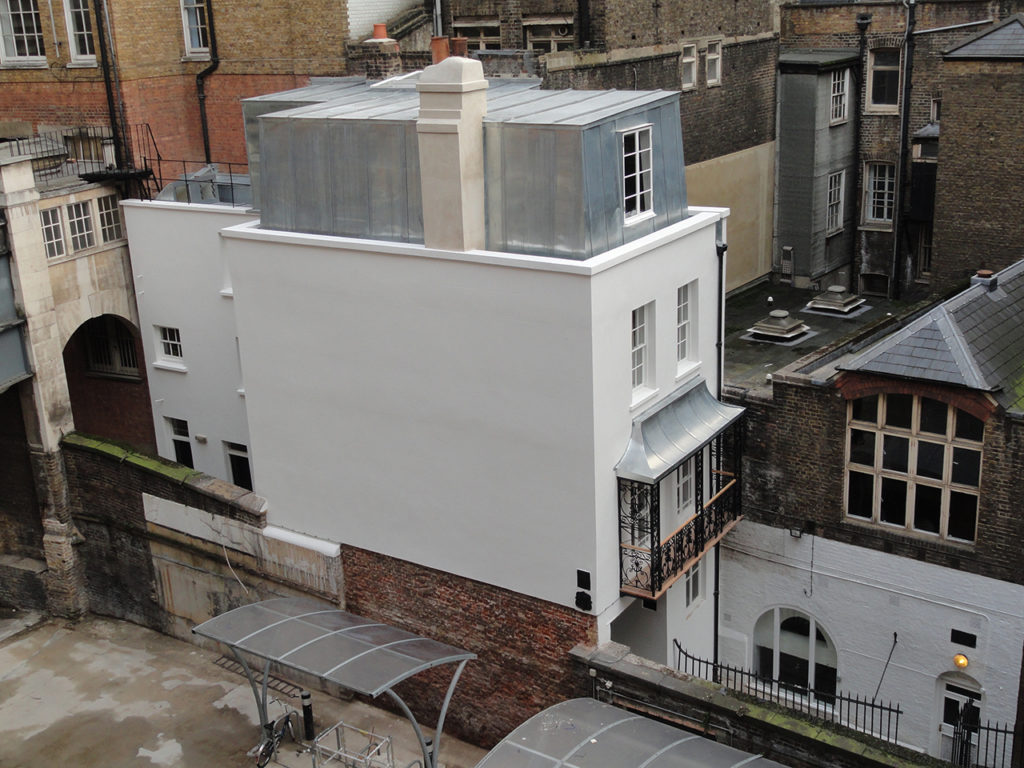The All-New Watch House
Posted in houses, Places, Strandlines and tagged with Duke of Somerset, King's College London, PAYE Conservation, Somerset House, Watch House

The scaffolding has recently come down from around the Old Watch House in Strand Lane, after a five-month restoration project sponsored by King’s College London and carried out by PAYE Conservation . It has been completely re-rendered, the zinc sheathing of the penthouse storey has been replaced, and the zinc, woodwork and wrought iron of the balcony facing down the Lane has been renewed.
The results look wonderful – do come and see – but an equally exciting outcome of the project is that we now also know much more about the history of the building than we did before. It had been obvious all along that older fabric might lurk under the stucco cladding and the Regency-period balcony. There are documents to show that already in 1724 the beadles of St Clement Danes had a house here, which projected over the Lane and rested on the wall of the old Somerset House. This building was also used as a round-house and lock-up by the parish watch. There is also evidence that the parish had had a prison somewhere on the Lane since 1605. But before the recent refurbishment work it could only be guessed how much if any of this older history was still there under the surface.
We now know for sure that the building is indeed a real patchwork of different periods, repeatedly modified over the centuries. The brickwork of the southern two-thirds of the main block (the part projecting over the Lane) belongs either to the late eighteenth or the early nineteenth century, which fits the external appearance. But the fabric of the northern third of this block (about 3.4 metres, starting from the north-west corner and extending almost to the full height of the building) has turned out to be substantially earlier – either early eighteenth-century or even, perhaps, late seventeenth. The photo above shows a general view along the west wall at first-floor level, looking north, with the older brickwork at the far end; here is a close-up of the older, northern end:
There are plenty of further signs of rebuilding and remodelling over time too. The second-floor windows, above the balcony, were clearly enlarged at some point, and on the ground floor, under the overhang, there is a blocked doorway and window:
Most exciting of all is what has emerged about the supporting wall on which the west side of the overhang rests, which is also the boundary of the original King’s campus, and thus also of the old Somerset House estate. Examination of a small exposed portion of this wall a few years ago established that some of it was likely to be at least as old as the later seventeenth century. Now that all the render has been removed, what has emerged is a much larger stretch of old brickwork, roughly 5.5 by 3.5 metres, in 47 courses rising to a row of bricks set on end, as if to mark the level of the top of the wall before the Watch House was built over it:
Expert analysis suggests that this is – give or take a little patching here and there – a single build not from the seventeenth century but from the sixteenth. If this is right, then what we have had here all along, only not been able to see, is a stretch of the boundary wall of the old Somerset House, as built either for the Duke of Somerset himself in around 1550, or for his successor as proprietor, Queen Elizabeth, in the following decades. Alternatively, it could be associated with the development of the east wing of the palace for Anne of Denmark in 1609-13. In any event, it’s clear that what has now been exposed is by a long way the largest surviving chunk of the fabric of the old Somerset House still visible above ground. It has been decided to leave this permanently on display, although as yet there are no arrangements to allow it to be visited, except by King’s College cyclists, and others whose ID cards authorise them to enter the bike-park. London History Day on 31 May and Open House 2017 in September are likely to be the first opportunities for more general public access. But the Watch House at least can be viewed from the outside during working hours on weekdays, by entering Strand Lane either via Surrey Steps off Surrey Street, or at its south end on Temple Place.







